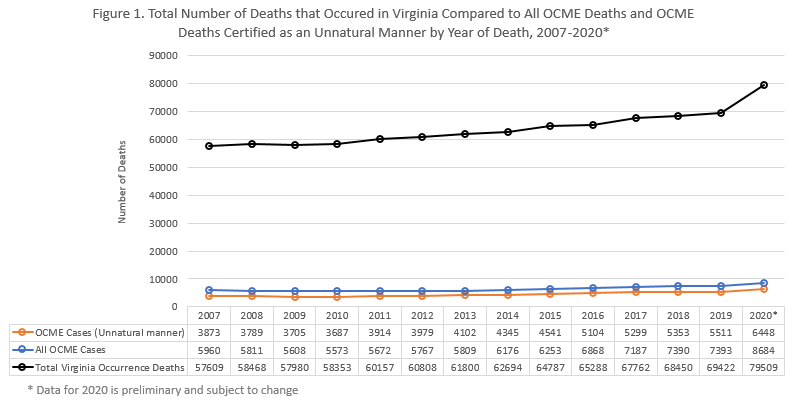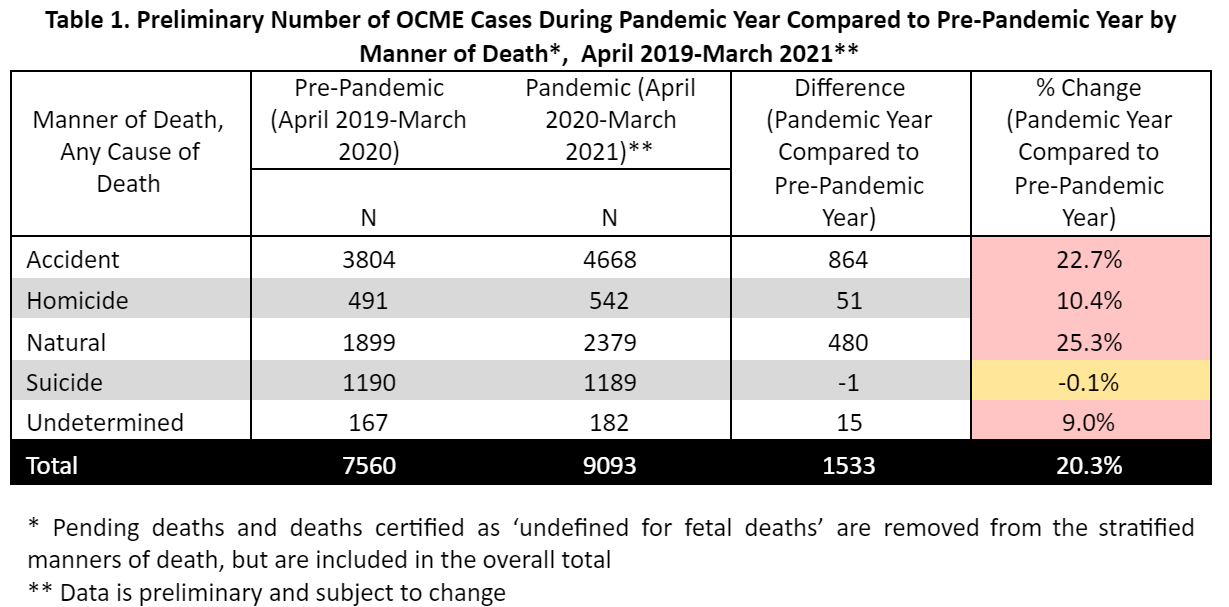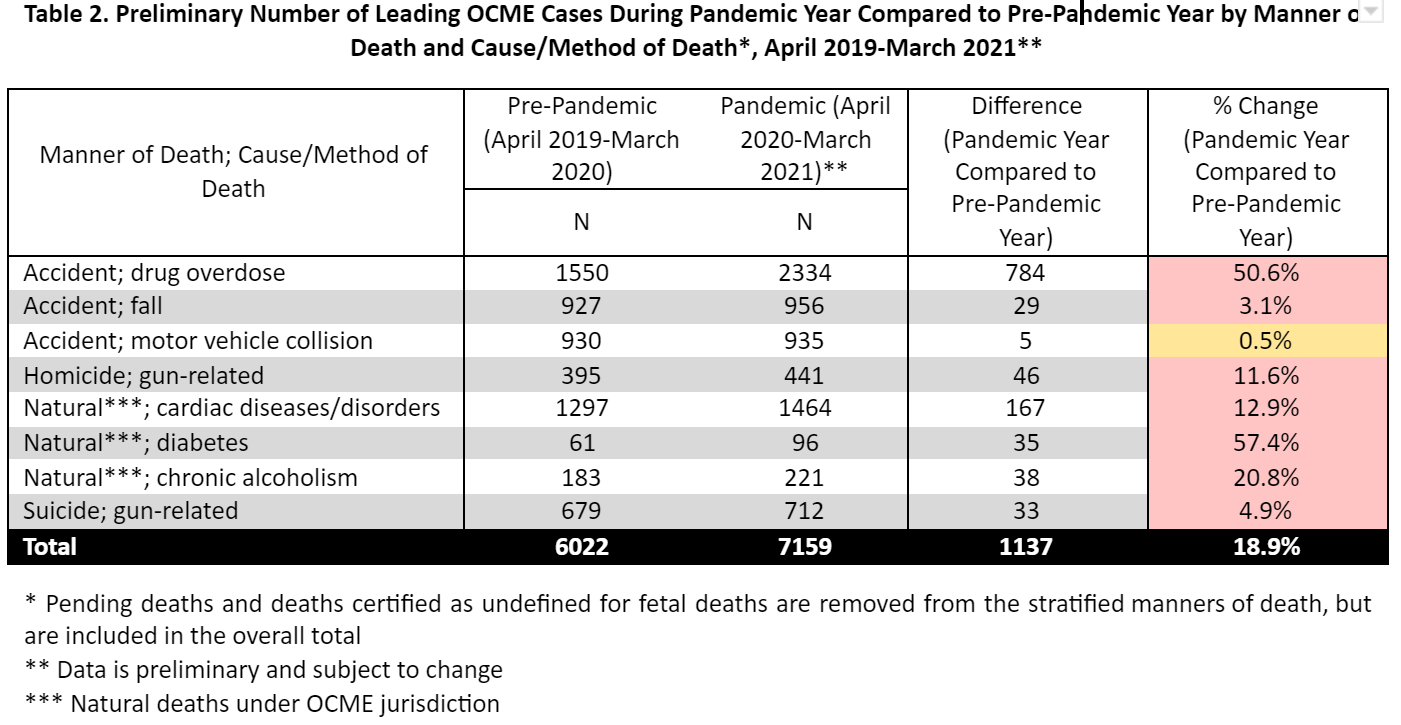Last Updated: October 26, 2021
by Katherin “Rosie” Hobron, MPH
What types of deaths fall under jurisdiction of the Office of the Chief Medical Examiner?
Pursuant to Code of Virginia § 32.1-283, the Office of the Chief Medical Examiner (OCME) investigates deaths due to trauma, injury, violence, poisoning, accident, suicide or homicide, or suddenly when in apparent good health, as well as deaths where the decedent had not been under the treatment of a physician in the last year. The OCME accepts all deaths of persons in-custody, whether in jail or prisons, and all deaths of residents of state mental health facilities. Annually, the OCME accepts approximately 10% of all deaths that occur in Virginia with roughly 7% of all deaths per year certified as an unnatural manner (accident, homicide, suicide, or undetermined). The remaining 90% or so are natural deaths in which the decedent’s primary care doctor or treating physician completes the death certificate (Figure 1).

Did the COVID-19 pandemic have an impact on fatality trends?
Like all other states in the nation, Virginia experienced a significant increase in all-cause mortality during the COVID-19 pandemic. Using Virginia Department of Health (VDH), Office of Vital Records (OVR) data from all death certificates of any cause (all-cause mortality) filed in the state, and adjusting for the first year of the pandemic (from here forward, the pandemic year period (PYP) will be used and is identified as April 2020 through March 2021), a preliminary total of 83,384 deaths occurred in Virginia during the first PYP. During the same timeframe of the previous non-pandemic year (April 2019 through March 2020), Virginia experienced 70,546 deaths, equating to an 18.2% increase in all-cause mortality during the first COVID-19 pandemic year. Previous year-to-year comparisons in non-pandemic years demonstrate that all-cause mortality numbers increase about 1-3% per year.
Most of the excess deaths (deaths over the expected average) identified during the PYP were due to COVID-19 fatalities that listed COVID-19 as a cause or contributor to death on the death certificate, or where after VDH investigations, COVID-19 was deemed a cause or contributor to death; however, not all excess deaths in Virginia were due to COVID-19. Although nearly all COVID-19 fatalities did not come under jurisdiction of the OCME per Code of Virginia, unless other circumstances of the death made it an OCME case, the OCME had a significant increase in death investigations during the PYP. Using the same comparison of the PYP compared to the previous non-pandemic year, the OCME accepted an additional 1,533 deaths under OCME jurisdiction; representing a 20.3% increase from the previous year. In the ten years prior, the OCME averaged a 3% increase in deaths accepted per year. During the PYP, the OCME certified a preliminary total of 209 COVID-19 fatalities of the well-over 10,000 confirmed COVID-19 fatalities in the state of Virginia during the same time frame.
What type of changes were identified in OCME cases during the pandemic?
Examining the different manners of death demonstrate significant changes to many of these categories during the pandemic. Comparing manner of death categories during the PYP to pre-pandemic highlight substantial increases in all manners of death except suicide. Accidents represented the largest numerical increase with 864 additional deaths, or an increase of 22.7%. Natural deaths under OCME jurisdiction represented the largest annual percentage increase of 25.3%, or 480 additional deaths. During the PYP, homicides were at record setting numbers for the last two decades with 51 additional homicides, or an increase of 10.4% from the previous year (Table 1).
Examining the data further, changes to various causes/methods of deaths during the PYP, in conjunction with different manners of death, were also discovered. Among the unnatural deaths, by far, the largest numerical and percentage increase during the PYP compared to the pre-pandemic year were among accidental drug overdoses with an increase of 50.6% (784 additional deaths). Gun-related homicides also increased significantly with 46 additional deaths, or an increase of 11.6%. Gun-related suicides and accidental falls increased slightly during the PYP. Accidental motor vehicle collisions were nearly identical to the previous year period (Table 2).
Among the natural deaths under OCME jurisdiction, the largest percentage increase during the PYP was among deaths due to diabetes and chronic alcoholism (57.4% and 20.8%, respectively). The largest numerical increase was identified among cardiac diseases/disorders with an increase of 12.9% (167 additional deaths) (Table 2). Understandably there were increases among pulmonary diseases/disorders and systemic diseases/disorders, but those increases were due to COVID-19 fatalities and were thus excluded from this analysis.


What are the main takeaways?
The COVID-19 pandemic was one of the largest public health events in recent history. Not only did the virus directly affect people who got sick, hospitalized, or died from illness, the virus and many of its public health control measures had many indirect effects on the population; some of which are demonstrated in the OCME mortality data. The over 18% increase in all-cause mortality numbers for the state of Virginia during the PYP is not only tragic, but put a significant strain on the workforce and resources of first responders, hospitals, fatality management, medical examiners, and funeral home operations dealing with the influx. For the OCME, an additional 1,533 deaths accepted under OCME jurisdiction during the PYP, an increase of over 20% from the previous year, highlights a substantial workload increase on a relatively small statewide medical examiner system.
The most overwhelming statistic from this analysis is the unprecedented increase in fatal accidental drug overdoses corresponding with the beginning of the pandemic and continuing well into the second PYP. This corresponds with most other states in the nation reporting large increases in fatal overdoses in the early weeks and months of the pandemic. Interestingly, the Virginia Department of Forensic Science, who tests all drugs seized from law enforcement confiscations across the state, experienced large decreases in drug submissions during the PYP. These decreases in law enforcement drug seizures may be due to a variety of different factors but strongly support the inverse relationship between decreased drug seizures and increased fatal drug overdoses.
Although homicides have generally been increasing each year, the annual total surpassed well over 500 homicides in 2020; the largest number and highest rate of homicide in Virginia in the last two decades. The near-identical number of suicides, all manners, during the PYP compared to the previous non-pandemic year was surprising. Since drug use and suicide have many of the same risk factors, one would assume that if one of those types of deaths was increasing, so would the other; however, that was not demonstrated in OCME data.
Both nationally and in Virginia, fatal motor vehicle collisions rank in the top three leading methods of unnatural death year after year. Interestingly, through the analysis for this report, accidental motor vehicle collisions appear unchanged during the PYP compared to the previous year; however, if you stratify motor vehicle deaths by month, there was a notable decrease in March through May 2020, which then rebounded to high numbers during the summer, and again decreased November 2020 through February 2021. Seasonal trends of motor vehicle fatalities are common, and tend to increase with more frequent driving for vacations in the summer and very poor, hazardous driving conditions like snow and ice during the winter, but decrease in spring and fall. Although monthly variation in motor vehicle fatalities were still apparent in 2020, the National Highway Traffic Safety Administration’s preliminary report indicated more people died in motor vehicle collisions in 2020 nationwide than in 2019. A more in-depth analysis should be performed on whether variations in community mitigation measures like stay-at-home orders, variations by state, peaks of disease burden, timing, etc. had a more direct association on motor vehicle deaths during the PYP.
The changes to the natural deaths under OCME jurisdiction were surprising. Although the vast majority of natural deaths do not fall under jurisdiction of the OCME, marked increases to natural deaths that do fall under OCME authority indicate a potential concern. Of the 480 additional natural deaths under OCME jurisdiction, all causes, during PYP compared to the pre-pandemic year, 209 were confirmed as COVID-19 deaths. Deaths of persons in-custody during the PYP was a notable contributor to the increase in natural deaths; many of which were due to COVID-19 outbreaks in various facilities across the state. Preliminary figures estimate over 90 additional deaths among persons in-custody of local, state, and federal correctional institutions during the PYP compared to the previous year.
Increases among diabetes and cardiac disease/disorders in the small portion of natural deaths under OCME jurisdiction also mirror similar trends seen nationally in leading causes of deaths during 2020 compared to 2019. Increases in chronic alcoholism deaths under OCME jurisdiction also increased, but were not included in the national top ten rankings of leading causes of death reported. National reports indicated large increases in alcohol sales during the pandemic and in part, may be an early indication of increases in alcohol abuse leading to deaths in the future.
Lastly, additional research into this topic should focus on demographic changes and regional differences to mortality numbers during the PYP. An in-depth analysis on this data may uncover notable variations to patterns of death during the PYP and would aid in averting those preventable deaths in the future.
Data notes and limitations
Data used for this analysis was obtained from the OCME’s Virginia Medical Examiners Data System on June 3, 2021. All data presented here should be considered preliminary and subject to change. Similar reports on mortality trends in Virginia, using other sources of similar data like OVR, should expect variations to numbers and interpretation due to case collection, classification, and methodology difference among OCME compared to other datasets.
